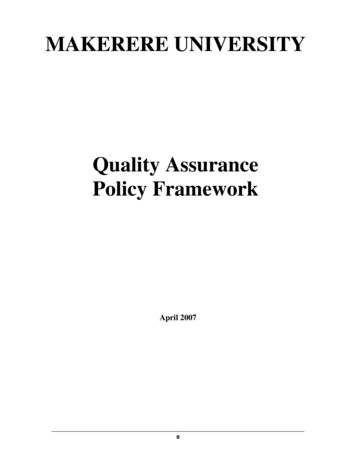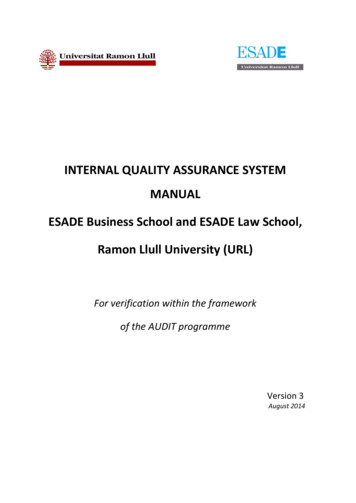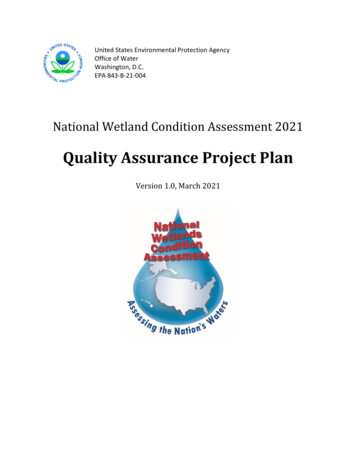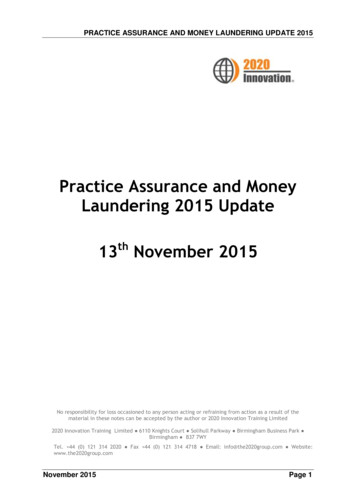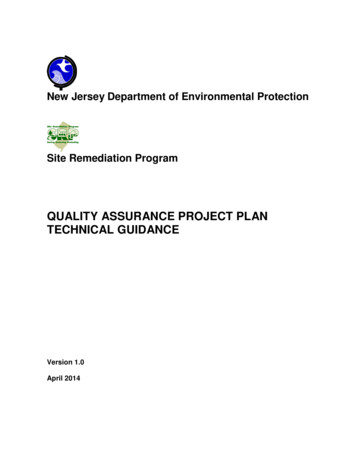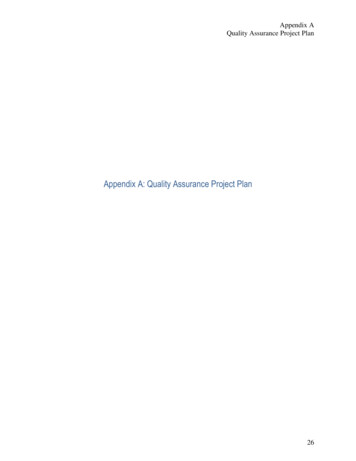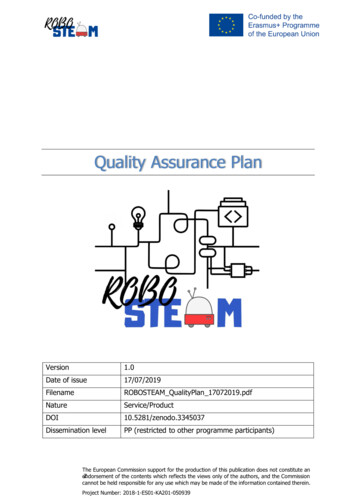
Transcription
Quality Assurance PlanVersion1.0Date of issue17/07/2019FilenameROBOSTEAM QualityPlan .3345037Dissemination levelPP (restricted to other programme participants)The European Commission support for the production of this publication does not constitute anzendorsementof the contents which reflects the views only of the authors, and the Commissioncannot be held responsible for any use which may be made of the information contained therein.Project Number: 2018-1-ES01-KA201-050939
Version History2VersionDateComments0.121/02/2019First draft of the Quality Plan1.017/07/2019Final Version of the Quality Plan2018-1-ES01-KA201-050939
Table of contents1INTRODUCTION . 42PURPOSE OF THE QUALITY ASSURANCE PLAN . 532.1Quality Assurance Approach . 52.2Quality Assurance Objectives . 62.3Evaluation Framework . 62.4Assesment Questions . 72.5Assesment Tools . 102.6Assessment Tools . 112.7Risk Analysis . 112.8Progress and final Evaluation Reports . 12KEY PERFORMANCE INDICATORS. 133.1Project Management Indicators . 133.2Consortium’s Engagement Indicators . 143.3Consortium’s Work Indicators . 153.4Dissemination Indicators . 163.5Intellectual Outputs Indicators . 163.6Teachers Training And Exchanges Of Groups Of Pupils Indicators . 174REFERENCES. 1832018-1-ES01-KA201-050939
1 INTRODUCTIONQuality management is an important process in all spheres of business life. It is notonly proved by the growing number of publications on quality assurance, but also bythe requirement of contractors for the implementation of such activities.Quality management is more than an externally-imposed obligation. It is seen as aninseparable part of project management, which ensures the quality of project’sprocesses and results. Therefore, all projects funded by the European Commissioninclude quality management in their work.Quality management process should satisfy the following four basic requirements: Usefulness, e.g. clearly defined goals for evaluation of the results; Feasibility, e.g. accurate planning of methods, time, costs; Fairness, e.g. respect to the “objects” of evaluation; Accuracy, e.g. production of valid results regarding the evaluation questions,aims and targets.The European Commission has set it as a requirement that all funded projects shouldplan quality management processes in order to: Simplify the consultation process within the project partnership; Predict the development of the project and prepare the project team forpressure points in the course of the project life span; Assist the project coordinator in quantifying results and relating these to theproject objectives.All partners will be involved in evaluation and quality assurance processes and willcommit to procedures of critical review and improvement.Quality management will provide practical and direct support for the projectimplementation. All partners will be involved in and committed to the procedures andactivities described in the following plan.42018-1-ES01-KA201-050939
2 PURPOSE OF THE QUALITY ASSURANCE PLANThe purpose of the Quality Assurance Plan, in addition to monitor the generalsatisfaction of the partners, is to ensure that the project activities are developed withinthe agreed timetable and with the agreed quality, according to the framework set toachieve the expected milestones and results.More in detail, the aim of quality assurance plan is to ensure that all partners contributewith the necessary documents and information to the correct development of theproject.In summary, the project Quality Assurance Plan, aims to: Create confidence in the quality of the work that the consortium will perform byshowing how the project will be carried out, measured, monitored, accountedfor and safeguarded during and after development, Define roles and responsibilities, with emphasis on the required skill sets toaddress the complexities and risks of the project, Show how changes and problems can be identified and reported, Clearly define the content, format, sign-off and review process, andresponsibilities for each output, Make visible all the means that are and will be applied to meet the technicaland quality requirements.2.1 Quality Assurance ApproachThe purpose for managing quality is to validate that the project outputs are completedwith an acceptable level of quality.Quality management assures the quality of the project outputs and of the processesused to develop the project activities and the outputs.Key components of the quality management plan are: Project outputs, which must respond to the expected quality standards and tostakeholders’ expectations Project processes, which must respond to the expected quality standards andto stakeholders’ expectationsThe quality management structure and procedures shall:52018-1-ES01-KA201-050939
Be adequate to the objectives and complexity of the project (activities asdescribed in the implementation section G of the proposal) Not be too time consuming. Not lead to a lack of flexibility in the project.That is why the Project Quality Assurance Plan is focused on specific activities andoutputs, which seem essential to the participants2.2 Quality Assurance ObjectivesThe main objectives of the quality management plan are to: Monitor the project progress Ensure the quality completeness of each activity and output separately and ofthe whole project Ensure the quality of the key processes and the key results of the project Identify possible bottlenecks and enable corrective activity2.3 Evaluation FrameworkQuality Assurance will focus on ensuring that all the activities, resources and objectivesplanned in the proposal are correctly executed, used and achieved. The qualityassurance plan developed early in the project (M1), will be implemented along theproject lifecycle and reports on the progresses will be provided in M6, 12, 18, 24(questionnaires and individual and group interview techniques to identify partnersperceptions and issues that may arise will be used) so to ensure timely completion ofthe work and early anticipation of problems and the support of the external evaluation.Organisation: It will be led by the USAL. All partners will be involved according to theirparticipation in the monitoring activities.The quality of the ROBOSTEAM project activities and results will be monitored througha continued assessment of the achievements against the agreed schedules for theproject. This will include regular reviews of the project, of the successful delivery ofproject activities, outputs, communications plans, dissemination and exploitationtargets and all other aspects of project delivery. Activities' leaders will be responsiblefor answering the questions and for data collection. The main instruments we will useare: questionnaires, face to face interviews, group discussions, document analysis andobservations. These monitoring tools will be developed by USAL as responsible of themonitoring and evaluation of the project.62018-1-ES01-KA201-050939
USAL will be responsible for providing progress and final quality reports (months 6,12, 18, 24). The interim reports will provide information on the evaluation activitycarried out during the previous months to assure the quality of the work actions carriedout, and the resources and other outcomes produced. They will include both feedbackon past project activities and recommendations regarding future activities. The finalreport will be produced at month 24 and will provide with information on the evaluationactivity carried out during the whole project and the results of these actions.It is intended that the USAL will facilitate both a formative and summative evaluationprocess to ensure that evaluation will be that part of the project where the partnersstand back and take stock. It is where each of the partners individually and as a groupwill: monitor what they are doing, with whom and how measure what they have done and achieved find out what was effective and what was not. Identify innovation and best practiceUSAL will organize the discussion during the face to face meetingsEvaluation will not be an add-on feature but an integrated part of the project to ensurethe learning, the products and the impact is sustained beyond the life of the fundingavailable. Evaluation is at its best when it is fully integrated into all project stages, sothis has been planned to be delivered as a formative evaluation process. The role ofthe internal evaluation process is crucial at each transnational meeting in particularasking: Can we learn from our mistakes? Can we pass on the benefits of our experience to others? Can we account for the money and resources being used?2.4 Assesment QuestionsEvaluation is about asking the right questions at the right time. The evaluation willconsider the following aspects at each stage as shown below:7 Clarity of Objectives Outcomes Targets and Measures. How clear are the objectives of the project? Are they well defined?2018-1-ES01-KA201-050939
Are they quantified?Design of evaluation will help decide on the best way to organise the project. Typicalquestions are: What is the most effective way to respond to particular problems? What have other communities with similar problems done? How effective have comparable projects been? What sort of outcomes can realistically be expected? What sort of resources, funds and skills will be required? What management will be needed? How clear are the objectives of the project? Are they well defined? Are they quantified?These are questions to be discussed at each transnational meeting. The results will besummarized by the use of questionnaires completed by each partner after eachmeeting as a formative part of the project evaluation.Process or interactive evaluation examines the project’s implementation and whetherit was delivered in the way it was intended. Typical questions are: Was the project implemented as planned? What led to any variations of the implementation plan? What does the project need to do in response to any changes? How significant are the changes in delivery (incremental or transformational)?The Outputs of the project at each stage of evaluation (interim and final) How is the project performing against these targets? At what stage were objectives agreed?o How effective is the project in working towards achieving its objectives?82018-1-ES01-KA201-050939
o How much of the outcome to date can be attributed to the project and howmuch to other factors (e.g. underlying trends or wider initiatives thatcomplemented the project)?o Is it possible to compare the project with a ‘control group’, who experiencethe same influences but are excluded from the project?o Has there been a demonstrable improvement in the quality ofteaching/teacher-parent-pupil communication?o Were there any changes in levels of problem being addressed?o Were there any unexpected effects?o What dissemination has taken place to date and how effective has this been?o What has been the impact of dissemination?How has dissemination informed the validation, exploitation and sustainability of theproject? Sustainability evaluation is to find out if the project will continue / bemainstreamed, typical questions are: Have risks and barriers been identified for taking the project forward? Have opportunities for joining up with other schools/associations been fullyconsidered? Have opportunities for leveraging been considered? Is the project 'future proofed'? Could the project be copied by other organisations? Would the benefits be different in those organisations? What leverage do the other organisations have? Are they in a position to mandate/ encourage/ facilitate wider adoption? Have they been involved in the project throughout its lifetime?Quality of theimplementation) Was the project delivered on time and within budgeted costs?2018-1-ES01-KA201-050939
What are the key lessons for the delivery of the project and what have youdone to disseminate them? How did the partnership operate? Was there conflict? How was consensus reached? What decision-making and steering mechanisms were employed? Who held accountability for delivery? Was this shared? How significant wastransformational)? Did the organizations have experience of using technology before theproject? E-delivery, how was take-up addressed and was this strategy successful? What support mechanisms were put in place to assist customers to useelectronic services? How was progress monitored against: a) delivery milestones; b) targetoutcomes? What have you done to disseminate these? (the evaluation will also ensurethere is constant review of dissemination activity throughout the projectimplementation) Once strategy and objectives where set, how smooth was implementation? What went wrong or could have been done better? How did leadership address the change and bring the organization on board? How has the project changed the organizations involved positives andnegatives?thechangeindelivery(incrementalor2.5 Assesment ToolsThe evaluation plan will be validated and followed by all participants in these activities(researchers, trainers, trainees, administrative staff, partner representatives, etc).102018-1-ES01-KA201-050939
Reports of these evaluation activities will be distributed to all partners and used duringthe life of the project to improve the project results and assure the good managementof the project.Evaluation questionnaires for transnational meetingsIn every partnership meeting all the partners will fill an evaluation questionnaireregarding the previous, present and future phases of the project, in order to identifypotential threats and have the opportunity to operate in a flexible manner. Reports ofthese evaluation activities will be distributed to all partners.The feedback-evaluation (needs, expectations, threats, important phases of theproject, national specificities regarding project’s procedures and objectives etc) isimportant because the leader of the work Evaluation and the coordinator haveinformation to manage better the project in the future, in a constructive way.Evaluation of the outputs and activitiesSpecial evaluation questionnaires will be created to assure the correctness and highquality of the joint staff training (C1) and the students exchange (C2, C3, C4, C5 andC6).Feedback and assessments from beneficiaries and wider stakeholders will be capturedwhere appropriate (O2, O3 and the multiplier events E1, E2 and E5) by questionnairesand semi-structured interviews.2.6 Assessment menthttp://robosteamproject.eu/moodle/ to support collaborative project working andassessments and above all the recording of all the different results, drafts and finalversion of documents, monitoring reports.This will allow all partners to share materials and knowledge in an effective way aswell as allowing them all to access and update the project web site remotely in a verysimple way. This tool will provide the focal point for project following of qualityactivities.There will be the feedback of the monitoring reports as well as the feedback from theevaluation questionnaires on the key components and outputs in an on-goingindicators scheme.2.7 Risk AnalysisThe measures to handle project risks will be captured in the development of a riskmapping and resolution plan. USAL will take over this as part within the monitoringand evaluation systems created for quality assurance. They will be strongly supported112018-1-ES01-KA201-050939
by the coordinator. The plan will help to identify who will be involved into therespective processes, the tools to be used, if required, the expected results and howto proceed in case the desired risk mitigation is not obtained. The steering committeewill resolve any major risk or conflict with a democratic vote.2.8 Progress and final Evaluation ReportsProgress and Final evaluation reports, on the evaluation of the outputs as comparedto those planned, their quality, their short-term and long-term impact, and on theevaluation of the coordination and effectiveness of the consortium will be written andapproved by the coordinator and all partners.These Reports (Progress and Final Evaluation Reports) will be the consolidation of allthe results of evaluation tools.122018-1-ES01-KA201-050939
3 KEY PERFORMANCE INDICATORS3.1 Project Management IndicatorsPerformance IndicatorQuality of projectmanagementarrangementsThemes/issues addressed in the evaluation commitment and equitable involvement of all partnersdetailed arrangements for implementation of workplans andadministration of budgetsclarity of project coordinationEffective managementand leadershipqualities demonstratedby project co-ordinator Effectiveness of theprocess of monitoringand evaluation quality of the proposals for on-going monitoring and al/national/European levelQuality of thedissemination process quality of the arrangementsinformation/resultsImplementation of theworkplan adherence to the workplan by all partnersdeviation from the workplan based on well-considered reasonsand mutual agreementIntegration of projectactivities into thedepartment's/institution'sdevelopment plan evidence of the project's integration into the development planand normal activities of the participating institutions13 professional competence and commitment displayed by projectco-ordinatorleadership qualitiesquality of relationship with partners and development ofteamworkfor disseminating project2018-1-ES01-KA201-050939
3.2 Consortium’s Engagement IndicatorsPerformance IndicatorStrong commitment to theproject by each gcommunicationamongstpartners and with otheragenciesTrust amongst ues addressed in the evaluation extent to which each partner is prepared to commit timeand resources as required in line with the jointly agreedwork plan willingness to resolve problems mutual understanding about project rationale, overall aimsand short-term/long-term objectives clear evidence in the workplan of sharing of roles andresponsibilities amongst partners effectiveness of communication with account being takenof any language difficulties clarity of communication, particularly by the project coordinator range. purpose, fullness and effectiveness of contacts andcommunications amongst partners and with otheragencies eg. National Agency, European Commission development of mutual trust throughout the life of theproject development amongst partners of a sense of ownership ofthe project development of positive attitudes towards Europe andtransnational activities2018-1-ES01-KA201-050939
3.3 Consortium’s Work IndicatorsPerformance IndicatorThemes/issues addressed in the evaluationStructure of the project clear rationale and clarity of objectivesrealistic timescalespertinence of topics and activitiesclarity and consistency of the general design of the projectQuality of the project quality of the project in terms of its short, medium andlong-term impact at local/regional/national/ EuropeanlevelQuality of projectmaterials/products quality of materials/guides/reports/products throughoutthe life-cycle of the projectQuality of the promotion ofthe European Dimension appropriate emphasis placed on the European dimensionin educationeffective promotion of knowledge and understandingabout Europe Innovation and variety ofapproach 15evidence of a varied range of approaches by all partnerswithin the projectuse, where appropriate, of innovative methodology andeffective use of new technologiesextent of the opportunity for partners to input their ownexpertise and learn from each other2018-1-ES01-KA201-050939
3.4 Dissemination IndicatorsPerformance IndicatorThemes/issues addressed in the evaluationCompletion ofdisseminationand exploitation activitiesPercentage of activities remaining to be completed withoutresulting to unfinished activities. Threshold for this indicatoris less than 20%Participation level fordissemination eventsNumber of expected users per dissemination tool and/oractivity with respect to the number of actual users perdissemination tools and/or activityDifference in % between expected users and actual users.Threshold for this indicator is a difference of less than 30%Perceived quality of the on-linedissemination activities andtoolsNumber of unique visitorsRepeating visitors3.5 Intellectual Outputs IndicatorsO2 (Guides for designing Open Hardware PD&R)Quantitative Indicators:Activities for measure and report:N of other primary data analyzedInterim and Final Project Reports (A1)Nº of applications of the kits to STEAMchallengesInterim and Quality Final Reports (A2)Qualitative Indicators:Activities for measure and report:Impact on and relevance on the developmentof O2Interim and Quality Final Reports (A2)Feedback from teachers and students of thepartner schoolsO3 (RoboSTEAM Environment)Quantitative Indicators:Activities for measure and report:Instruments and methods downloadedInterim and Final Project Reports (A1)Instruments and methods compiledInterim and Quality Final Reports (A2)Registered usersNº answers to the evaluation toolsQualitative Indicators:Activities for measure and report:Satisfaction of RoboSTEAM membersInterim and Final Project Reports (A1)Interim and Quality Final Reports (A2)Answers to the evaluation tools162018-1-ES01-KA201-050939
3.6 Teachers Training And Exchanges Of Groups Of Pupils IndicatorsC1 SP-SCHOOL-EVENT - Short-term joint staff training events M18 - GermanyQuantitative Indicators:Activities for measure and report:N of teachers attending (planned 18)Interim and Final Project Reports (A1)N of trainers attendingInterim and Quality Final Reports (A2)N of days of training (planned 5)Qualitative Indicators:Activities for measure and report:Feedback (through questionnaires) from teachers Interim and Quality Final Reports (A2)attending the training eventsC2 SP-SCHOOL-EXCH - Short-term exchanges of groups of pupils M13 - SpainQuantitative Indicators:Activities for measure and report:N of teachers attending (planned 4)Interim and Final Project Reports (A1)N of pupils (planned 10)Interim and Quality Final Reports (A2)N of days of training (planned 5)Qualitative Indicators:Activities for measure and report:Feedback (through questionnaires) from teachers Interim and Quality Final Reports (A2)and pupilsC3 SP-SCHOOL-EXCH - Short-term exchanges of groups of pupils M13 - PortugalQuantitative Indicators:Activities for measure and report:N of teachers attending (planned 2)Interim and Final Project Reports (A1)N of pupils (planned 5)Interim and Quality Final Reports (A2)N of days of training (planned 5)Qualitative Indicators:Activities for measure and report:Feedback (through questionnaires) from teachers Interim and Quality Final Reports (A2)and pupilsC4 SP-SCHOOL-EXCH - Short-term exchanges of groups of pupils M17 - SpainQuantitative Indicators:Activities for measure and report:N of teachers attending (planned 2)Interim and Final Project Reports (A1)N of pupils (planned 5)Interim and Quality Final Reports (A2)N of days of training (planned 5)Qualitative Indicators:Activities for measure and report:feedbacks (through questionnaires) from teachers Interim and Quality Final Reports (A2)and pupilsC5 SP-SCHOOL-EXCH - Short-term exchanges of groups of pupils M17 - PortugalQuantitative Indicators:Activities for measure and report:N of teachers attending (planned 2)Interim and Final Project Reports (A1)N of pupils (planned 5)Interim and Quality Final Reports (A2)N of days of training (planned 5)Qualitative Indicators:Activities for measure and report:Feedback (through questionnaires) from teachers Interim and Quality Final Reports (A2)and pupilsC6 SP-SCHOOL-EXCH - Short-term exchanges of groups of pupils M18 – FinlandQuantitative Indicators:Activities for measure and report:N of teachers attending (planned 6)Interim and Final Project Reports (A1)N of pupils (planned 15)Interim and Quality Final Reports (A2)N of days of training (planned 5)Qualitative Indicators:Activities for measure and report:Feedback (through questionnaires) from teachers Interim and Quality Final Reports (A2)and pupils172018-1-ES01-KA201-050939
4 REFERENCES[1][2]18F. J. García-Peñalvo, "O3 RoboSTEAM Environment – First overview and discussions," presentedin RoboSTEAM Erasmus project Kick-Off, Bragança, Portugal, February 15-16, 2019, 2019.Available from: https://goo.gl/hro7tc. doi: 10.5281/zenodo.2571497.RoboSTEAM Consortium, "RoboSTEAM Project," presented in RoboSTEAM Erasmus projectKick-Off, Bragança, Portugal, February 15-16, 2019, 2019. Available from:https://goo.gl/Ni43mK. doi: 10.5281/zenodo.2575066.2018-1-ES01-KA201-050939
Quality Assurance Plan Version 1.0 Date of issue 17/07/2019 Filename ROBOSTEAM_QualityPlan_17072019.pdf Nature Service/Product DOI 10.5281/zenodo.3345037 Dissemination level PP (restricted to other programme participants) 2 2018-1-ES01-KA201-050939 Version History Version Date Comments .
